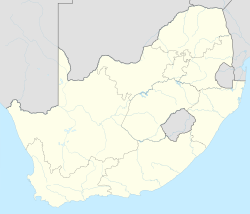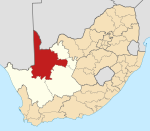world.wikisort.org - South_Africa
Postmasburg is a town in the Northern Cape province of South Africa.
Postmasburg | |
|---|---|
 Postmasburg  Postmasburg | |
| Coordinates: 28.3279°S 23.0706°E | |
| Country | South Africa |
| Province | Northern Cape |
| District | ZF Mgcawu |
| Municipality | Tsantsabane |
| Area | |
| • Total | 158.41 km2 (61.16 sq mi) |
| Population (2011)[1] | |
| • Total | 30,089 |
| • Density | 190/km2 (490/sq mi) |
| Racial makeup (2011) | |
| • Black African | 54.6% |
| • Coloured | 36.8% |
| • Indian/Asian | 0.5% |
| • White | 7.4% |
| • Other | 0.7% |
| First languages (2011) | |
| • Afrikaans | 53.9% |
| • Tswana | 33.6% |
| • Xhosa | 2.7% |
| • Sotho | 2.6% |
| • Other | 7.2% |
| Time zone | UTC+2 (SAST) |
| Postal code (street) | 8420 |
| PO box | 8420 |
| Area code | 053 |
Location
The Town is located approximately 170 km east of Upington.[2]
The town is 67 km (42 mi) north of Griquatown and 58 km (36 mi) west-south-west of Daniëlskuil.
History
Originally a station of the London Missionary Society called Sibiling, it became a Griqua village with the name Blinkklip. It was proclaimed a town on 6 June 1892 and named after the Reverend Dirk Postma (1818-1890), founder of the Reformed Church.[3]
The town achieved municipal status in 1936.
Army
The South African Army's Combat Training Centre is located nearby, at Lohatla.
Sport
The town is home to Hungry Lions, a soccer team playing in the National First Division.[4]
Economy
Postmasburg is home to Kolomela Mine which is owned by Anglo American. The Iron Ore mine officially opened in June 2012 provides job opportunities for the local communities and a green hydrogen plant is estimated to be built by 2029 by Thabiso Dube to form more job opportunities.[5]
See also
- Redstone Solar Thermal Power
- Jasper Solar Energy Project
- Lesedi Solar Park
References
- "Main Place Postmasburg". Census 2011.
- "Postmasburg". northerncape.org.za. Retrieved 27 March 2009.
- "Dictionary of Southern African Place Names (Public Domain)". Human Science Research Council. p. 374.
- "Hungry Lions are champions". SAFA.net. 3 July 2021. Retrieved 16 September 2021.
- "KUMBA IRON ORE OFFICIALLY OPENS ITS KOLOMELA MINE". Angloamerican.com. 22 June 2012.
На других языках
[de] Postmasburg
Postmasburg ist eine Stadt in der südafrikanischen Provinz Nordkap. Sie ist Verwaltungssitz der Gemeinde Tsantsabane im Distrikt ZF Mgcawu.- [en] Postmasburg
Другой контент может иметь иную лицензию. Перед использованием материалов сайта WikiSort.org внимательно изучите правила лицензирования конкретных элементов наполнения сайта.
WikiSort.org - проект по пересортировке и дополнению контента Википедии
